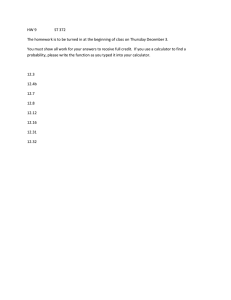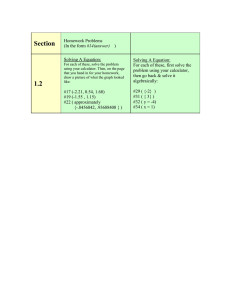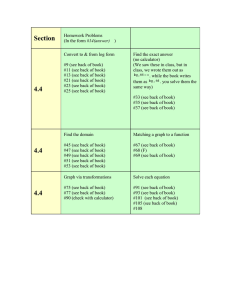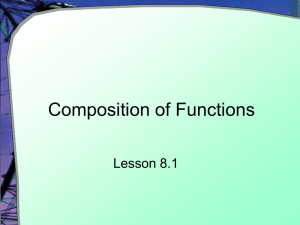Critical Path Analysis for the Execution of Parallel and
advertisement
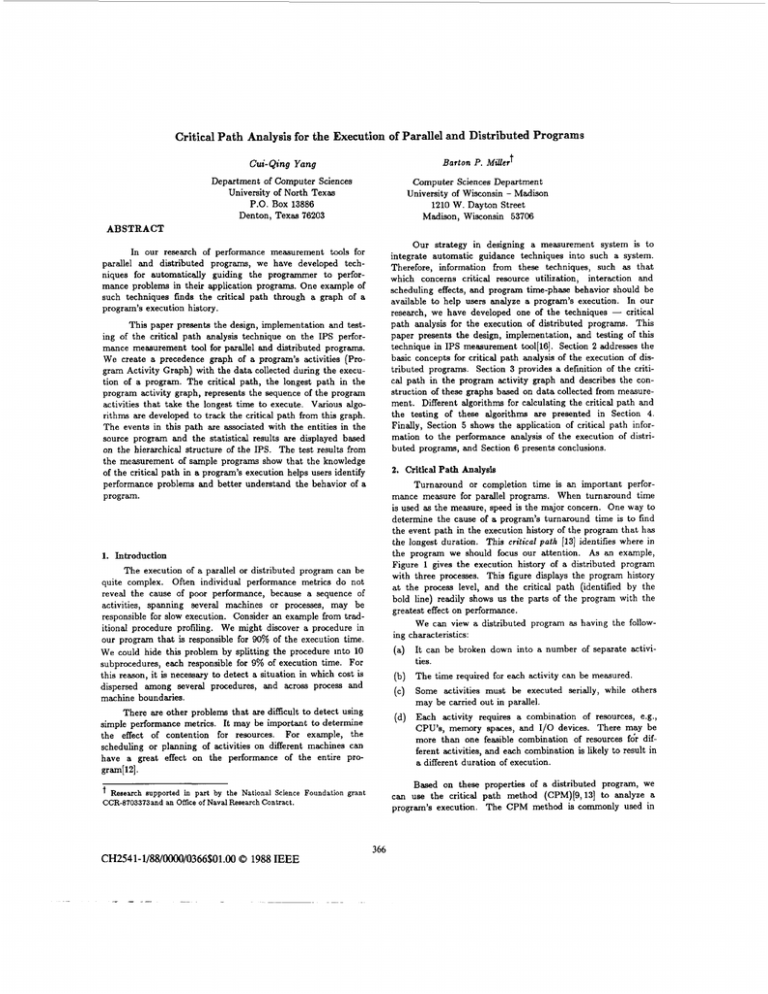
Critical Path Analysis for the Execution of Parallel and Distributed Programs
Cui-Qing Yang
Barton P. M&rt
Department of Computer Sciences
University of North Texas
P.O. Box 13886
Denton, Texas 76203
Computer Sciences Department
University of Wisconsin - Madison
1210 W. Dayton Street
Madison, Wisconsin 53706
ABSTRACT
Our strategy in designing a measurement system is to
integrate automatic guidance techniques into such a system.
Therefore, information from these techniques, such as that
which concerns critical resource utilization, interaction and
scheduling effects, and program time-phase behavior should be
available to help users analyze a program’s execution. In our
research, we have developed one of the techniques - critical
path analysis for the execution of distributed programs. This
paper presents the design, implementation, and testing of this
technique in IPS measurement tool[l6]. Section 2 addresses the
basic concepts for critical path analysis of the execution of distributed programs. Section 3 provides a definition of the critical path in the program activity graph and describes the construction of these graphs based on data collected from measurement. Different algorithms for calculating the critical path and
the testing of these algorithms are presented in Section 4.
Finally, Section 5 shows the application of critical path information to the performance analysis of the execution of distributed programs, and Section 6 presents conclusions.
In our research of performance measurement tools for
parallel and distributed programs, we have developed techniques for automatically guiding the programmer to performance problems in their application programs. One example of
such techniques finds the critical path through a graph of a
program’s execution history.
This paper presents the design, implementation and testing of the critical path analysis technique on the IPS performance measurement tool for parallel and distributed programs.
We create a precedence graph of a program’s activities (Program Activity Graph) with the data collected during the execution of a program. The critical path, the longest path in the
program activity graph, represents the sequence of the program
activities that take the longest time to execute. Various algorithms are developed to track the critical path from this graph.
The events in this path are associated with the entities in the
source program and the statistical results are displayed based
on the hierarchical structure of the IPS. The test results from
the measurement of sample programs show that the knowledge
of the critical path in a program’s execution helps users identify
performance problems and better understand the behavior of a
program.
2. Critical Path Analysis
Turnaround or completion time is an important performance m e s u r e for parallel programs. When turnaround time
is used as the measure, speed is the major concern. One way to
determine the cause of a program’s turnaround time is to find
the event path in the execution history of the program that has
the longest duration. This critical path 1131 identifies where in
the program we should focus our attention. As an example,
Figure 1 gives the execution history of a distributed program
with three processes. This figure displays the program history
at the process level, and the critical path (identified by the
bold line) readily shows us the parts of the program with the
greatest effect on performance.
We can view a distributed program as having the following characteristics:
1. Introduction
The execution of a parallel or distributed program can be
quite complex. Often individual performance metrics do not
reveal the cause of poor performance, because a sequence of
activities, spanning several machines or processes, may be
responsible for slow execution. Consider an example from traditional procedure profiling. We might discover a procedure in
our program that is responsible for 90% of the execution time.
We could hide this problem by splitting the procedure into 10
subpmcedures, each responsible for 9% of execution time. For
this reason, it is necessary to detect a situation in which cost is
dispersed among several procedures, and across process and
machine boundaries.
It can be broken down into a number of separate activities.
The time required for each activity can be measured.
Some activities must be executed serially, while others
may be carried out in parallel.
There are other problems that are difficult to detect using
simple performance metrics. It may be important to determine
the effect of contention for resources. For example, the
scheduling or planning of activities on different machines can
have a great effect on the performance of the entire program[l2].
Each activity requires a combination of resources, e.g.,
CPU’s, memory spaces, and 1/0 devices. There may be
more than one feasible combination of resources fdr different activities, and each combination is likely to result in
a different duration of execution.
Based on these Droperties of a distributed program, we
can use the critical ;at; method (CPM)[9,13] to analyze a
program’s execution. The CPM method is commonly used in
Research supported in part by the National Science Foundation grant
CCR-8703373and an Office of Naval Research Contract.
CH2541-1/88/0000/0366$01.000 1988 IEEE
366
operational research for planning and scheduling, and has also
been used to evaluate concurrency in distributed simulations[2].
Process2
1
3.1. Definitions
The definition of program activity graph is similar to that
of an activity network in project planning(61. The execution of
distributed programs can be divided into many nonoverlapping
individual jobs, called activities. Each activity requires some
amount of time, called the duration. A precedence relationship
exists among the activities, such that some activities must be
finished before others can start. Therefore, a PAG is defined as
a weighted, and directed multigraph, that represents program
activities and their precedence relationship during a program’s
execution. Each edge represents an activity, and its weight
represents the duration of the activity. The vertices represent
beginnings and endings of activities and are the eoents in the
program (e.g., send/receive and process creation/termination
events). A dummy activity in a PAG is an edge with zero
weight that represents only a precedence relationship and not
any real work in the program. More than one edge can exist
between the same two vertices in a PAG.
Process 3
_---<Sde!n{
6
Rcv
The critical path for the execution of a distributed program is defined as the longest weighted path in the program
activity graph. The length of a critical path is the sum of the
weights of edges on that path.
Figure I: Example of Critical P a t h
In contrast t o CPM, the technique used in our critical
path analysis (CPA) is based on the execution history of a program. We can find the path in the program’s execution history
that took the longest time to execute. Along this path, we can
identify the place(s) where the execution of the program took
the longest time. The knowledge of this path and of the
bottleneck(s) along it will help us focus on the performance
problem.
3.2. Construction of Program Activity G r a p h
A program activity graph is constructed from the data
collected during a program’s execution. There are two requirements for the construction of program activity graphs: first,
the activities and events represented in a PAG should be
measurable in the execution of programs; second, the activities
Turnaround time is not the only critical measure of the
performance of parallel programs. Often the throughput is
more important, e.g., in high-speed transaction systems[l4].
While, our discussion concentrates on the issue of critical pa;:.
analysis for turnaround time, the techniques we use to present
CPA result (see Section 5.1) are directly applicable to
throughput.
in a PAG should obey the same precedence relationship as do
program activities during the execution.
Two classes of activity considered in our model of distributed computation are computation and communication. For
computation activity, the two basic PAG events are starting
and terminating events. The communication events are based
on the semantics of our target system, the Charlotte distributed
operating system[l]. We can build similar graphs for systems
with different communication semantics. In Charlotte, the
basic communication primitives are message Send, Rcv and
Wait system calls. A Send or Rcv call issues a user communication request to the system and returns to the user process
without blocking. A Wait call blocks the user process and
waits for the completion of previously issued Send or Rcv
activity. Corresponding to these system calls are four communication events defined in the PAG: send-call, rcv-call,
wait-send, and wait-rcv. These primitive events allow us to
model communication activities in a program. We show, in
Figure 2, a simple PAG for message send and receive activities
3. Program Activity Graph
To calculate critical paths for the execution of distributed
programs, we first need to build graphs that represent program
activities during the program’s execution. We call these graphs
program activity graphs (PAGs). The longest path in a program activity graph represents the critical path in the
program’s execution. In this section, we define the program
activity graph and related ideas. We then describe how various
communication primitives of distributed programs are
represented in program activity graphs and how these graphs
are built on the basis of information obtained from program
measurement.
361
in a program. Two extra events of transmit-start and
transmit-end are included in Figure 2a to depict the underlying relationship among various communication events. They
represent the actual data transmission inside the operating system. Since these extra events occur below the application program level, we do not consider them in our PAG. Therefore,
we transform the graph in Figure 2a into that in Figure 2b and
still preserve the precedence relationship among the basic communication events.
4.1. Assumptions and Our Testing Environment
Since all edges in a PAG represent a forward progression
of time, no cycles can exist in the graph. T o find the longest
path in such graphs is a much simpler problem than in graphs
with cycles. Most shortest path algorithms can be easily modified to find longest paths of the acyclic graphs. Therefore, in
the following discussion, we consider those shortest-path algorithms to be applicable to our longest-path problem.
A program activity graph consists of several subgraphs
that are stored in different host machines. The data to build
these subgraphs are collected during the execution of application programs. We can copy subgraphs between node
machines; the copying time is included in the execution time of
algorithms. All subgraphs were sent to one machine to test the
centralized algorithm. In testing the distributed algorithm,
subgraphs were either locally processed or sent to some collection of machines to be regrouped into bigger subgraphs.
The weights of message communication edges in Figure 2b
t,
t , md, and t, ,),
represent the message delivery
time for differkt activities- Message delivery time is different
for local and remote messages, and is also affected by message
length. A general formula for calculating message delivery
times is: t = T , + T , x L , where L is the message length, and T,
and T, are parameters of the operating system and the network. We have conducted a series of tests to measure values of
these parameters for Charlotte. We calculated average T, and
T, for different message activities (intra- and inter-machine
sends and receives) by measuring the round trip times of intraand inter-machine messages for loo00 messages, with message
lengths from 0 to the Charlotte maximum packet size. These
parameters are used to calculate the weight of edges when we
construct PAGs for application programs.
(ted,
We used two application programs to generate PAGs for
testing the longest path algorithms. Application 1 is a group of
processes in a master-slave structure, and Application 2 is a
pipeline structure. Both programs have adjustable parameters.
By varying these parameters, we vary the size of the problem
and the size of generated PAG's. In graphs generated from
Application 1, more than 50% of the total vertices were in one
subgraph, while the remaining ones were evenly distributed
among the other subgraphs. The vertices in the graphs from
Application 2 were evenly distributed among all subgraphs.
I
Rcv-call
K
J.
transmil-end
+
(a) Detailed Version
I I
All of our tests were run on VAX-11/750 machines. The
centralized algorithms ran under 4.3BSD UNIX,and the distributed algorithms ran on the Charlotte distributed operating
system[11.
6
4.2. Test of Different Algorithms
(b) Simplified Version
We chose the PDM shortest-path algorithm as the basis
for our implementation of centralized algorithm[7]. The experiments of Denardo and Fox[5], Dial et al[8], Pape[l8], and
Vliet[lS] show that, on the average, the PDM algorithm is faster than other shortest-path algorithms if the input graph has a
low edges-to-vertices ratio (in our graphs, the ratio is about 2).
An outline of the PDM algorithm and a brief proof for the
correctness of the algorithm are given in [20]. More detailed
discussion of the algorithm can be found in [7].'
Figure 2: Constmetion of S i l e Program Activity Graph
4. Algorithm of Critical Path Analysis
An important side issue is how to compute the critical
path information efficiently. After a PAG is created, the critical path is the longest path in the graph. Algorithms for finding such paths are well studied in graph theory. We have
implemented a distributed algorithm for finding the one-to-all
longest paths from a designated source vertex to all other vertices. A centralized algorithm was also tested as a standard for
comparison with distributed algorithms. In this section, we
describe some details of the implementation and testing of
these algorithms, and provide comparisons between them.
Our implementation of the distributed longest path algorithm is based on Chandy and Misra's distributed shortest
path algorithm[3]. Every process represents a vertex in the
graph in their algorithm. However, we chose to represent a
sub-graph instead of a single vertex in each process because the
368
number of total processes in the Charlotte system is limited
and we were testing with graphs having thousands of vertices.
The algorithm is implemented in such a way that there is a
process for each sub-graph, and each process has a job queue
for work at vertices in the sub-graph (labeling the current longest length to a vertex). Messages are sent between processes for
passing information across sub-graphs (processes). Each process keeps individual message queues to its neighbor processes.
An outline of the two versions of the distributed algorithm and
a proof of the correctness of the algorithm appear in [ZO]. A
detailed discussion of the algorithm is given by Chandy and
Misra[3].
We tested our algorithms with graphs derived from the
measurement of the execution of Applications 1 and 2. The
total number of vertices in the graphs varies from a few
thousand to more than 10,OOO. Speed-up (S) and efficiency
( E ) are used to compare the performance of the distributed
and centralized algorithms. Speed-up is defined as the ratio
between the execution time of the centralized algorithm (T,)to
Sped-up
APPUCATION I
41
31
I
IVMOI4
S
erriI
P
APPUCATlONl
CY
APPUCATION 1
IvI=m
/+
the execution time of the distributed algorithm ( T d ) :S = T, /
T d . Efficiency is defined as the ratio of the speed-up to the
number of machines used in the algorithm: E = S / N.
We used input graphs with different sizes and ran the
centralized and distributed algorithms on up to 9 machines.
Speed-up and efficiency were plotted against the number of
machines. The results are shown in Figures 3, 4, 5, and 6. We
can see from these measurements that the distributed algorithm with larger input graphs and more machines resulted in
greater speed-up but less efficiency.
I
We have observed a speed-up of almost 4 with 9 machines
for the distributed algorithm. Speed-up increases with the size
of the input graph and the number of machines participating
in the algorithm. On the other hand, the efficiency of the algorithm decreases as more machines are involved in the algorithm. The sequential nature of synchronous execution of
diffusing computations determines that the computations in an
individual machine have to wait for synchronization at each
step of the algorithm. As a result, the overall concurrency in
the algorithm is restricted, and the communication overhead
with more machines offsets the gain of the speed-up.
1
3
1
5
6
x M.rhinn
7
8
9
10
6: Speedup dDIstrihded AIgdthm
1
3
4
5
6
I M.shm.,
7
8
9
10
Flg.13 Dmdery dDLstrihded W U U n
behavior of a program. In this section, we first give a brief
description of the system and the program with which we have
conducted our tests. Then, we present some of the measurement results in relating to the information from the critical
path analysis. The final discussion addresses the problem of
the minimum length of the critical path in a program's execution.
5.1. Test System and Test Program
Measurement Tests with the Technique of Critical Path
Analysis
5.
All of our tests with the technique of critical path analysis
were run on the IPS performance measurement system for
parallel and distributed programs[l6,ZO]. IPS uses a hierarchical model as the framework for performance measurement. The
hierarchical model maps program's behavior to different levels
of abstraction, and unifies performance data from the whole
program level down to procedure and statement level. IPS provides a wide range of performance information about a
We have conducted a set of tests in using the technique of
critical path analysis for the performance measurement of distributed application programs. The goal of these tests is to
show how automatic guidance techniques can be integrated in
a performance measurement tool, and how these guidance
information can help us to better understand the performance
369
program’s execution. This information includes performance
metrics at different levels of detail, histograms of the basic
metrics, and guidance information from the critical path
analysis. An interactive user interface with simple command
menu is supported in the IPS. Programmers can interactively
evaluate the performance history of a distributed program after
the program terminates normally.
tion costs affect the program’s execution, and which process
(controller or calculator) has a bigger impact on the program’s
behavior.
The critical path analysis technique in IPS provides guidance for finding possible bottlenecks in a program’s execution.
The critical path information is represented by the percentages
of communication and CPU time of the various parts of the
program along the total length of the path. Figure 7 gives the
critical path information at the program level. We can see that
the communication cost (including inter-machine and intramachine messages) is more than one third of the total length of
the critical path. This reflects the fact that the communication
overhead in Charlotte is relatively high compared to other systems[l].
The presentation of results of critical path analysis offers
some interesting problems. A PAG may contain more than
100,ooO nodes; the critical path may contain a nontrivial percentage of these nodes. We use statistical presentation techniques to display the (time weighted) most commonly occurring
nodes, and the most commonly occurring sequences in the
path. We then use high-level language debugging techniques
to relate these events directly to the source program. Observing the most commonly occurring sequences allows us to detect
performance bottlenecks that span procedure, process, or
machine boundaries. Performance problem that are divided
among several procedures, or even among processes or
machines, are readily apparent.
Inter-machine Msg
Intra-machine Msg
Total
The program we have chosen for measurement tests on
the IPS system is an implementation of the Simple2 method for
linear progra”ing[4, 111. The so-called columnwise distribution algorithm works in a master-slave model. With the given
problem defined as a matrix, a controller (master) process coordinates the computation in multiple calculator (slave) processes
to obtain an optimal solution. All slave processes use the same
program code but work on different columnwise data of the
matrix. The configuration for our test is set as follows: the
input matrix size is 36x36, the program has a controller process
and 8 calculator processes, and these processes run on 3 node
machines.
1360
16667
100
Figure 7: Critical Path Information at Program Level
Entry Name
P(1,3) CPU
P(1,3)->P(3,5) Msg
P( 3,5)->P( 1,3) Msg
P(1,3)->P(2,5) Msg
P(2,5)->P(1,3) Msg
P(3,4)->P(1,3) Msg
P( 1,3)->P(3,4) Mag
P( 1,3)->P(2,4) Msg
P(2,4)->P(1,3) Msg
P(1,3)->P(1,5) Msg
P(1,5)->P(1,3) Msg
P( 1,3)->P(1,4) Msg
P (1,4)->P (1.3) Msg
P (1,3)->P (3,3) Msg
P(3,3)->P(1,3) Msg
P(3,5) CPU
P(1,5) CPU
P(2,5) CPU
P(3,4) CPU
P(2,4) CPU
P(1,4) CPU
P(3,3) CPU
Total
5.2. Some Test Results
We start our measurement session by examining the information from various metrics and histograms in IPS. We can
learn about many aspects of the program’s behavior from this
information, and have a general picture of the program’s execution. For instance, the parallelism of the program is not high
(around 1.15); there is considerable communication between
the controller and calculator processes (about 700 messages);
and each calculator process has light work load and spends
most of the time in waiting for messages (11% of the time in
computing, 85% of the time in waiting for messages, and 4% of
the time in waiting for CPU). However, all this information is
mainly applicable to individual items in the program. It tells
us little about the interactions among different parts of a
program, and about how these interactions affect the overall
behavior of a program’s execution. Therefore, it is still difficult
to discover why the parallelism is low, how much communica-
Time(m)
9140
840
840
480
480
480
480
440
440
408
408
272
212
240
240
159
108
88
79
67
64
42
16667
( P ( i j ) denotes process j in machine i,
%
58
5
5
3
3
3
3
3
3
2
2
2
2
1
1
1
1
1
*
*
*
*
100
denotes lesa than 1%)
Figure 8: Critical Path Information at Process Level
The critical path information at the process level (see Figure 8) gives us more details about the program’s execution.
The execution of the controller process takes 58% of the whole
length of the critical path, while the execution of all calculator
37u
processes take less that 5% of the whole length. The domination of the controller process in the critical path restricts the
overall concurrency of the program. This explains why the
parallelism for the current configuration is so low. From the
length of the critical path, we can calculate the maximum
parallelism of the program[lO, 151, which equals the ratio
between the total CPU time and the length of the critical path.
This maximum parallelism depends upon the structure and the
interactions among the different parts of the program. The
maximum parallelism for the program under our tests (with 8
calculators running on 3 machines) is only 1.91. The communication costs and the CPU load effects in different machines
lowered the real parallelism to 1.15.
Procedure Name
MainLoop
Sendchild
hit
read1
Checkwaiting
MainLoop
recv
MainLoop
MainLoop
MainLoop
MainLoop
MainLoop
Total CPU
Mach. Process ID
(Mach 1, Proc 3)
(Mach 1, Proc 3)
(Mach 1, Proc 3)
(Machl, Proc 3)
(hlach 1, Proc 3)
(Mach 3, Proc 4)
(Mach 1, Proc 3)
(Mach 3, Proc 5)
(Mach 1, Proc 5)
(Mach 2, Proc 4)
(Mach 1, Proc 4)
(Mach 2, Proc 5)
Time(%)
& Calculator Processes
21
17
11
4
4
1
1
1
1
1
Figure 1 0 Program Elapsed Time in Ditrerent Configurations
We can observe that, to a certain extent, for this fixed initial problem, having fewer calculator processes gives a better
result. The execution time (also the length of the critical path)
has its minimum when the program runs with 3 calculators.
However, if the number of calculator processes gets too small (2
in this case), each calculator has to d o too much work and
creates a bottleneck. Note that the test using 2 calculator
processes is best with respect to the assignment of processes to
machines (only one process per machine). While in the 3 calculator case the controller process is running on the same
machine as a calculator process. Therefore, the contention for
CPU time among processes is not the major factor that affects
the overall execution time of the program.
*
*
62
(* denotes less than
1%)
Figure 9: Critical Path Information at Procedure Level
Finally, we display critical path information at the procedure level in Figure 9. This information is useful in locating
performance problems across machine and process boundaries.
The top three procedures, that take 49% of the entire length of
the critical path, are in the controller process. Procedure
MainLoop in the calculator processes, which is in charge of
communications between calculators and the controller, takes
33% of the entire execution time of each calculator process.
However, they are much less noticeable in the critical path
because of the dominance of the controller process.
Fracuon 01 Critical Pal11 1.coglh
5.3. Discussion
We have seen that the execution of the controller process
dominates the performance behavior. This is because, in our
test configuration, the controller process serves too many (8)
calculator processes, but each calculator process is lightly
loaded. One way to cope with the problem is to reduce the
number of calculator processes in the program. We have conducted a set of measurement tests with our test program having 2 to 8 calculator processes for the same 36x36 input matrix,
running on 3 machines. The test results are shown in Figure
(a) Process Coniponents
(b) Message Componenls
Figure 11: Components of the Critical Path
The critical path information for these tests (shown in
10.
37 1
7. Appendix
Figure 11) supports our observation. For the configuration of 3
calculator processes, the controller and calculator processes
have the best balanced processing loads, and the lowest message overhead. This coincides with the shortest execution time
in Figure 10. The Simplex program has a master-slave structure. The ratio between computation times for the controller
and calculator processes on the critical path reflects the balancing of the processing loads between the master and slaves in
the program. We have observed that when the master and
slave processes have evenly distributed processing loads
(dynamically, not statically), the program shows the best turnaround time. Otherwise, if the master process dominates the
processing, the performance suffers due to the serial execution
of the master process. On the other hand, if the slave processes
dominated, it would be passible to add more slaves. The
Appendix contains a proof that supports our claim that for programs with the master-slave structure, the length of the critical
path in the program’s execution is at its minimum when the
path length is evenly distributed between master and slave
processes.
In the following discussion, we give a simple proof to support our claim that for programs with the master-slave structure, the length of the critical path in the program’s execution
reaches the minimum when the whole path length is evenly
distributed between master and slave processes. Our proof
applies the related study in Mohan’s thesis[l7] to the aspect of
critical path length.
n
(
hlaSIer
]
Figure 12: Master-Slave Structure
The last observation from our tests is that the critical
path information in our discussion ignores the delays caused by
competition for the external resources as CPU’s, so that it
depends entirely on the structure of the program. Actually, we
can calculate the critical path, using the real elapsed time with
delays caused by processes waiting for the CPU on a machine.
Therefore, the results of CPA will also reflect the interactions
and scheduling of the concurrent events in a program.
Assume that a general master-slave structure is
represented as N slave processes working synchronously under
the control of a master process (see Figure 12). Let a computation have a total computing time of C , consisting of the time
for master, C,, and the time for slaves, C, (for simplicity, all
times are deterministic). The computation time in the master
process includes one part for a fixed processing time (e.g., initialization, result reporting time), F,, and another part of per
slave service time (e.g., job allocating, partial results collecting,
and communication times with slaves in the program of the
Therefore,
Simplex method), c,.
C, = N e ,
F,.
Assume F, is negligible compared to Nc,, i.e., F, >> Nc,; we
have:
C, = Ne,.
6. Conclusion
The technique of critical path analysis (CPA) is one
method that we developed to provide guidance for locating performance problem in the program. A PAG is created from the
data collected during program’s execution. The longest path in
this graph represents the critical path in the execution of the
program. We have implemented different algorithms to calculate the critical path in a PAG. Due to the acyclic nature of
PAG’s, these algorithm are simple and efficient.
+
The nature of the synchronization pattern in the masterslave structure determines that the execution of the master process is serialized with the concurrent execution of N slave
processes. Hence, the length of the critical path in the
program’s execution, L , ( N ) , is:
The experimental measurements conducted on the IPS
system with sample application programs show that the
knowledge about the critical path in a program’s execution
helps programmers identify the possible bottlenecks in the program. In addition, this information also allows users to predict
the program behavior under different configurations. It is possible to accommodate various guidance techniques in a performance measurement tool. Developing these guiding techniques
for performance measurement of parallel and distributed programs exposes a new research area which requires a combined
knowledge of disciplines such as performance measurement,
program semantics, and algorithm design.
L , ( N ) = C,
-
C,
N
To find the minimum of L , ( N ) , we have:
and
N
=-\I”.
,C
312
c,
N
+ - = Ne, + -:
d (Le(NI) - e , - - = c.
-o,
dN
NZ
“Speedup Versus Efficiency in Parallel Systems,” Tech.
Report 86-08-01, Dept. of Computer Science, University
of Washington (August 1986).
dN
minimum value a t the point. Therefore, the minimum length
of the critical path is:
[ll] Raphael Finkel, Bahman Barzideh, Chandreshekhar W.
Bhide, Man-On Lam, Donald Nelson, Ramesh Polisetty,
Sriram Rajaraman, Igor Steinbeig, and G. A. Venkatesh,
“Experience with Crystal, Charlotte and Lynx (Second
Report),” Tech. Report #649,, Computer Sciences Dept.,
University of Wisconsin-Madison (July 1986).
C.
In this equation, both master and
of share
in the length of
indicates that the length of the
minimum when the entire length
ter and slave processes.
(m)
slaves have the same amount
the critical path. This result
critical path reaches to the
is evenly distributed in mas-
[12] Bernard Lint and Tilak Agerwala, “Communication Issues
in the Design and Analysis of Parallel Algorithms,” IEEE
Transactions on Software Engineering SE-7(2) pp. 174-188
(March 1981).
8. References
Yeshayaliu Artsy, Hung-Yang Chang, and Raphael
Finkel, “Interprocess Communication in Charlotte,” IEEE
Software 4(1) pp. 22-28 (January 1987).
1131 K. G. Lockyer, A n Introduction to Critical Path Analysis,
Pitman Publishing Company (1967).
(141 L.F. Mackert and G. M. Lohman, “R* Optimizer Validation and Performance Evaluation for Distributed
Queries,” Research Report, IBM Almaden Research
Center (January 1986).
0. Berry and D.Jefferson, “Critical Path Analysis of Distributed Simulation,’’ Proc. of Conf. on Distributed Simulation 1985, (January 1985).
K. M. Chandy and J. Misra, “Distributed Computation
on Graphs: Shortest Path Algorithms,” Communications
of the AGM 25(11) pp. 833-837 (November 1982).
[15] B.P. Miller, “DPM: A Measurement System for Distributed Programs,” IEEE Transactions on Computers, (to
appear 1987).
G. B. Dantzig, Linear Programming and Eztensions,
Priceton University Press, Princeton, N J (1963).
[16] Barton P. Miller and Cuiqing kang, “IPS: An Interactive
and Automatic Performance Measurement Tool for Parallel and Distributed Programs,” Proceedings of the 7th
International Conference on Distributed Computing Systems, IEEE Computer Society, Berlin, FRG (September
21-25, 1987).
E.V. Denardo and B.L. Fox, “Shortest-route methods: 1.
reaching, pruning, and buckets,” Operations Research
27(1) pp. 161-186 (Jan.- Feb. 1979).
Narsingh Deo, Graph Theory with Applications to
Engineering and Computer Science, Prentice-Hall, Inc.,
Englewood Cliffs, N. J . (1974).
[17] J . Mohan, “Performance of parallel programs: model and
analyses.,” CMU-CS-84-141, Ph.D. Thesis, Carnegie Mellon U. Comp.Sci.Dept. (1984.).
Narsingh Deo, C. Y. Pang, and R. E. Lord, “Two Parallel
Algorithms for Shortest Path Problems,” Proc. of the
1980 International conference on Parallel Processing, pp.
244-253 (August 1980).
[18] U. Pape, “Implementation and efilciency of Moorealgorithms for the shortest route problems -- a review,”
Math. Programming 7(2) pp. 212-222 (October 1974).
R.B. Dial, F. Glover, D Karney, and D. Klingman, “A
computational analysis of alternative algorithms and labeling techniques for finding shortest path trees,” Networks
9(3) pp. 215-248 (Fall 1979).
[19] D. Van Vliet, “Improved shortest path algorithm for transporation networks,” Trasportation Research 12(1) pp. 720 (Feburary 1978).
W. E. Duckworth, A. E. Gear, and A. G. Lockett, “A
Guide to Operational Research,” John Wiley 6‘ Sons, New
York, (1977).
1201 Cuiqing Yang, “A Structured and Automatic Approach
to the Performance Measurement of Parallel and Distributed Programs,” Tech. Report 713 Computer Sciences
Dept. , Univ. of Wisconsin-Madison (August 1987).
Derek L. Eager, John Zahorjan, and Edward D. Lazowska,
31 3
